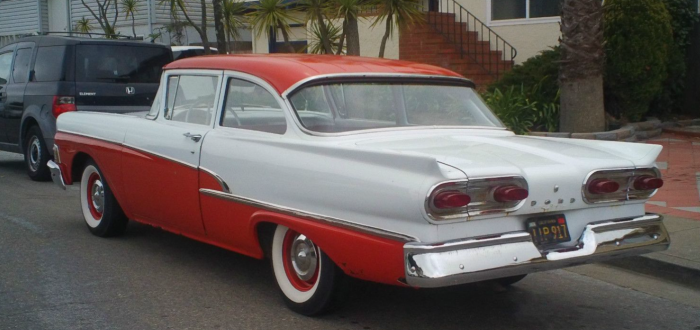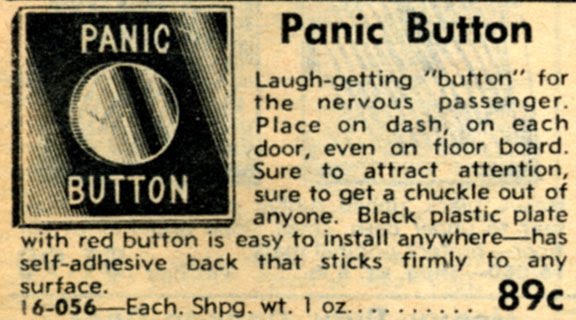My first car was a ’57 Ford Custom in Dresden Blue.
My Ford was solid blue, not two-tone like this one.
Last Tuesday, I related how my first time (to drive 100 mph) was in a ’57 Studebaker Golden Hawk in Tulia, Texas, 1963. Today, we have more “Tales From Tulia.” To once again give you the context, Tulia, Texas is in the Panhandle, located roughly equidistant between Amarillo on the north and my hometown of Lubbock to the south. It is and always has been a farming community. When I lived there in the early 1960s, the population was growing and had reached a little over 6,000. Now the town has declined to around 4,000.
My mother’s family lived in Tulia. My maternal grandfather had come to Tulia after World War I. He had been raised in Cambridge, in Guernsey County, Ohio where his family had migrated from Guernsey Isle. Sufficient numbers of people from Guernsey had settled in and around Cambridge that the County took its name from the Isle. My mother’s family had come to Guernsey from Normandy during the Huguenot Persecutions in the 16th century.
After coming to Swisher County, Texas (of which Tulia is the county seat) after World War I, my grandfather married Imogene Simmons. He farmed near the community of Red Hill northeast of Tulia. My mother was born there. During the Depression, the family moved back to Cambridge. My grandfather worked at the now-defunct Cambridge Glass Works. To you antique collectors, Cambridge Glass is now a highly sought after collectable. Later my grandfather moved the family back to Tulia.
I was born in Lubbock, Texas, some 70 miles south of Tulia. My mother had gone to Lubbock to attend Texas Tech and to study nursing. Both my mother and her sister, Susie, became Registered Nurses.
In last week’s “Gear Head Tuesday,” I wrote that I was working at a local supermarket, Griffith Food Town, after school and on weekends. For reasons I no longer recall, I left Food Town and started working at Littlejohn Bros. Supermarket, located on Broadway in Tulia. The store had been built in 1949 by brothers Jack and Tommy Littlejohn. The brothers were graduates of Texas A&M University and had served in World War II. When I was working at the store, Tommy was no longer active in running the store and worked as a realtor. Jack operated the store. Both brothers were proud of having gone to A&M – at a time in Texas where the school was the butt of many jokes. Besides the school’s emphasis on Agriculture and Mechanical Engineering, it was also a school that turned out many fine officers for the U.S. Army to the point that General George Patton claimed (perhaps apocryphally) “Give me an army of West Point graduates, and I’ll win a battle. Give me a handful of Texas Aggies, and I’ll win a war.”
My Uncle Jerry, who is only slightly older than I am, had a green ’52 DeSoto hardtop equipped with Fluid Drive.
A&M is also famous for its marching band and both Littlejohn brothers had been in the famous A&M band. The brothers carried themselves with the proud, upright posture that had become an Aggie trademark.
As I wrote above, the Littlejohn Bros. Supermarket was on Broadway, a.k.a. “Dip Street.” When the town of Tulia had been laid out, Broadway was designed to live up to its name. It was, indeed, A Broad Way, a four lane street, paved with bricks, with islands of grass and trees between the east and west bound lanes. Broadway also had deep dips at each intersecting cross street. The dips were intended to channel rainwater during rainstorms, which in the Texas Panhandle (particularly during tornado season), can be quite torrential. For some reason lost in the mists of time, the street was built with these dips rather than underground water channels. During a rainstorm, the dips would fill with water and invite adventuresome drivers to splash their cars through the deep troughs of rain.
“Dip Street” became known throughout the Panhandle. Teenage drivers, especially on Friday nights and the weekends, cruised the street. Visitors from other towns would come to Tulia to “drag Dip Street.”
“Dip Street” was anchored at the west end by the Santa Fe Railway depot and the Ozark Trail monument on the east end at Maxwell Street. The ritual was to honk at those you knew at each dip, even if you had honked at them only moments before.
“Dip Street” was anchored on the west end of Broadway by the Santa Fe Railway depot and by the Ozark Trail monument on the east at Maxwell Street.
So the drill was to make the rounds on “Dip Street,” honking at your friends, then for variety, turn left onto Maxwell, drive north to 6th Street, left onto 6th Street to just before Highway 87, pull into Hawkins Dairy Queen, get a Coke or a hot pineapple fried pie topped with Dairy Queen, turn right out of the Dairy Queen back onto N.W. 6th Street to Highway 87, left onto 87 and back to Dip Street and repeat. All the while, we listened to radio station KOMA, whose powerful signal beamed from Oklahoma City, playing the tunes we remember from the ’60s.
My car was a Dresden Blue ’57 Ford Custom that I had bought from Don Shackelford when he ordered a new Ford Falcon Sprint V8 hardtop from John Wilkerson Ford. It was a very basic car, but had Ford’s 272 cubic inch V8. It had a three speed manual transmission. Don had installed a Hurst floor shifter and had “souped up” the engine by fitting it with the heads from a Thunderbird 312 V8 and the 4 barrel carburetor, also from a T-Bird 312. Don was a keen drag racer and often beat cars with bigger engines at the impromptu drag strip east of town on Farm-to-Market Road 1318.
Jody White was another Tulia High School boy who frequented “Dip Street.” Jody drove a red and white ’58 Ford Custom 300. Kelly Clower, Peter Overgaard, an exchange student from Denmark, Jody and I were sitting in Jody’s car in front of Tulia High listening to KOMA, drinking some cherry schnapps Peter had brought from Denmark, when the news came over the radio that President Kennedy had been shot in Dallas.
Jody White drove a ’58 Ford Custom.
Richard Davis was a high school football “jock,” and had a most disagreeable personality. The ONLY thing I liked about him was his father had a ’55 Studebaker President, one of the very few Studebakers in this town of Fords and Chevys with the occasional Mopar (owned by my mother’s extended family thrown in.) If you understand the football culture of Texas, Oklahoma and throughout the South, you understand that football jocks are like gods. But Davis was so disagreeable that even the other football gods in Tulia disliked him. Herein lies a tale. Bear with me while I set the stage.
Farmers use sodium nitrate as a weed killer. Some “genius” had figured out that if you mix equal parts of sodium nitrate with sugar and set a match to it, it will light off in a blinding flame. One of my high school buddies was Mike Sweatt, a farm boy. Mike’s father had 100 lb. bags of sodium nitrate. I worked in a grocery store. Being a store that catered to farming families, we stocked 100 lb. bags of sugar. Farm wives bought sugar in 100 lb. bags, especially during “canning season.”
Mike, Don Shackelford and I decided we would play a trick on Davis. Mike (ahem) “borrowed” a 100 lb. bag of sodium nitrate from his father. I bought a 100 lb. bag of sugar from Littlejohn Bros. We mixed the two together and one Friday night, Mike, Don and I loaded the mixture into the trunk of my Ford and set out for the Davis house on the south side of town. Mike and Don poured a trail of the mixture around the perimeter of the lawn of the Davis house. I stayed in the car with the passenger door open and the engine running for a quick get away. Don stayed at a place near my car, lighter in hand to touch off the nitrate-sugar mixture and Mike furiously rang the doorbell just as Don set the flame. The mixture did its job and lit the perimeter up like daylight as Mike and Don jumped into my car. We sped off as the Davises poured out of the house to see what was lighting up their yard like high noon sunshine! In the confusion, they didn’t really notice my car and they never figured out who had done this to them!
From there, we rewarded ourselves with a treat from Hawkins’ Dairy Queen and resumed our Friday night drag on “Dip Street,” still laughing at what we had done.
Disagreeable football jock Richard Davis’ father had a ’55 Studebaker President.
• • • •
Gems from the J.C. Whitney Catalog









Love a good story. I guess many towns had that favorite street to ‘DRAG’. The word has lost it’s meaning in today’s world. LOL
Love the panic button.
I am still trying to recover….. it is slow at 77.
LikeLike
Love the football jock story and I could be persuaded to take the Blue Studebaker off his hands !
Hey…. is your area OK with all the fires ?
cheers, parsnip
LikeLike
Had fun reading. Exited about reading about Peter Overgaard. Was a friend of mine while him in Tulia and me in Memphis Tx. With dips there on every intersection including splashes after rain. Heard anythin about Peter ? Regards Heiner Lüdemann Germany.
LikeLike
Thank you for visiting my blog – I no longer post to it but I have left it online.
I have not heard from Peter since he returned to Denmark!
I don’t know that he would remember me, but I certainly remember him!
LikeLike